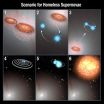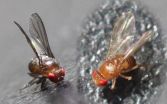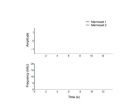(Press-News.org) Scientists have been fascinated by a series of unusual exploding stars -- outcasts beyond the typical cozy confines of their galaxies. A new analysis of 13 supernovae -- including archived data from NASA's Hubble Space Telescope -- is helping astronomers explain how some young stars exploded sooner than expected, hurling them to a lonely place far from their host galaxies.
It's a complicated mystery of double-star systems, merging galaxies, and twin black holes that began in 2000 when the first such supernova was discovered, according to study leader Ryan Foley, University of Illinois at Urbana-Champaign. "This story has taken lots of twists and turns, and I was surprised every step of the way," he said. "We knew these stars had to be far from the source of their explosion as supernovae and wanted to find out how they arrived at their current homes."
Foley thought that the doomed stars had somehow migrated to their final resting spots. To prove his idea, he studied data from the Lick Observatory in California and the W. M. Keck Observatory and the Subaru Telescope, both in Hawaii, to determine how fast the stars were traveling. To his surprise, he discovered that the doomed stars were zipping along at about the same speed as stars that have been tossed out of our Milky Way galaxy by its central supermassive black hole, at more than 5 million miles (7 million kilometers) an hour.
The astronomer then turned his attention to the aging galaxies in the area of the speeding supernovae. Studying Hubble archival images, he confirmed that many are massive elliptical galaxies that were merging or had recently merged with other galaxies. The lanes are the shredded remnants of a cannibalized galaxy. Other observations provided circumstantial evidence for such encounters, showing that the cores of many of these galaxies had active supermassive black holes fueled by the collision. Many of the galaxies also reside in dense environments at the heart of galaxy clusters, a prime area for mergers. The telltale clue was strong dust lanes piercing through the centers of several of them.
The location of the supernovae in relation to ancient galaxies indicates that the original stars must have been old, too, Foley reasoned. And if the stars were old, then they must have had companions with them that provided enough material to trigger a supernova blast.
How does a double-star system escape the boundaries of a galaxy?
Foley hypothesizes that a pair of supermassive black holes in the merging galaxies can provide the gravitational slingshot to rocket the binary stars into intergalactic space. Hubble observations reveal that nearly every galaxy has a massive black hole at its center. According to Foley's scenario, after two galaxies merge, their black holes migrate to the center of the new galaxy, each with a trailing a cluster of stars. As the black holes dance around each other, slowly getting closer, one of the binary stars in the black holes' entourage may wander too close to the other black hole. Many of these stars will be flung far away, and those ejected stars in surviving binary systems will orbit even closer after the encounter, which speeds up the merger.
"With a single black hole, occasionally a star will wander too close to it and have an extreme interaction," Foley said. "With two black holes, there are two reservoirs of stars being dragged close to another black hole. This dramatically increases the likelihood that a star is ejected." While the black hole at the center of the Milky Way may eject about one star a century, a binary supermassive black hole may kick out 100 stars a year.
After getting booted out of the galaxy, the binary stars move closer together as their orbits continue to accelerate which speeds up the binary stars' aging process. The binary stars are likely both white dwarfs, which are burned out relics of stars. Eventually, the white dwarfs get close enough that one is ripped apart by tidal forces. As material from the dead star is quickly dumped onto the surviving star, an explosion occurs, causing the supernova.
The time it takes for one of these ejected stars to explode is relatively short, about 50 million years. Normally, these kinds of binary stars take a long time to merge, probably much longer than the age of the universe, which is more than 13 billion years.
"The interaction with the black holes shortens that fuse," Foley explained.
While scientists think they have found what causes these outcast supernovae, some mysteries remain unsolved, such as why they are unusually weak. These supernovae produced more than five times as much calcium as other stellar explosions. Normally, supernova explosions have enough energy to create much heavier elements, such as iron and nickel, at the expense of producing the lighter calcium. However, for these atypical explosions, the fusion chain stops midway, leaving lots of calcium and very little iron.
"Everything points to a weak explosion," said Foley. "We know that these blasts have lower kinetic energy and less luminosity than typical supernovae. They also appear to have less ejected mass, whereas a more energetic explosion should completely unbind the star."
INFORMATION:
The results appear in the Aug. 13 issue of the Monthly Notices of the Royal Astronomical Society.
For images and more about this study and the Hubble Space Telescope, visit:
http://www.nasa.gov/hubble
http://hubblesite.org/news/2015/28
New research from North Carolina State University and Reed College shows that when fruit flies are attacked by parasites or bacteria they respond by producing offspring with greater genetic variability. This extra genetic variability may give the offspring an increased chance of survival when faced with the same pathogens. These findings demonstrate that parents may purposefully alter the genotypes of their offspring.
Fruit flies' reproductive cells are usually haploid, meaning that there is only one copy of each chromosome in the cell's nucleus instead of two. During ...
This news release is available in Japanese.
As nonhuman primates mature, their vocalizations are thought to be minimally or not at all influenced by caregivers - but a new study reveals that infant marmosets use cues from adults as they develop vocalizations. In a surprise twist then, humans may not be the only primates whose vocal development benefits from early communication. To monitor and measure the vocal development in marmosets, Daniel Takahashi et al. recorded vocalizations between the first day of birth and two months of age, using four well-established ...
This news release is available in Japanese.
Amid climate change debates revolving around limited increases in recent global mean surface temperature (GMST) rates, Kevin Trenberth argues that natural climate fluxes - larger than commonly appreciated - can overwhelm background warming, making plateaued rates, or hiatuses, deceiving in significance. After many years of monitoring, it's clear that the GMST can vary from year to year, even decade to decade; these differences, Trenberth argues, are largely a result of internal natural variability. For example, the Pacific ...
This news release is available in Japanese.
The recently commissioned Gemini Planet Imager has made its first exoplanet discovery: what may be the lowest-mass exoplanet ever directly imaged with a space telescope instrument. Based on available data, the researchers project the planet weighs twice as much as Jupiter - far less than exoplanets directly imaged before, which weighed at least five times Jupiter's mass. The findings from the next-generation Gemini imaging tool pave the way toward a better understanding of how our solar system was formed. In ...
The Gemini Planet Imager has discovered and photographed its first planet, a methane-enshrouded gas giant much like Jupiter that may hold the key to understanding how large planets form in the swirling accretion disks around stars.
The GPI instrument, which is mounted on the 8-meter Gemini South telescope in Chile, is the size of a small car and was designed, built and optimized for imaging and analyzing the atmospheres of faint Jupiter-like planets next to bright stars, thanks to a device that masks the star's glare.
In December 2104, GPI began searching hundreds of ...
A Jupiter-like planet within a young system that could serve as a decoder ring for understanding how planets formed around our Sun has been discovered by a team of astronomers from the University of Montreal's Institute of Research on Exoplanets (iREx) in collaboration with an international team of astronomers led by professor Bruce MacInstosh from Stanford University. One of the best ways to learn how our solar system evolved is in fact to look to younger star systems in the early stages of development.
The new planet, called 51 Eridani b, is the first exoplanet discovered ...
While it may not shock you to learn that children born with disorders of sex development (DSD) face challenges, Concordia University researchers have confirmed that these go far beyond the physical.
In a paper published in the journal Hormone and Metabolic Research, psychology professor William M. Bukowski and his co-authors Elizabeth McCauley and Thomas Mazur examine the potential effects that these disorders can have on children's and adolescents' peer relationships.
The term "disorders of sex development" covers a range of conditions, from physical malformations ...
Fifteen years ago, an odd mutant fruit fly caught the attention and curiosity of Dr. Ravi Allada, a circadian rhythms expert at Northwestern University, leading the neuroscientist to recently discover how an animal's biological clock wakes it up in the morning and puts it to sleep at night.
The clock's mechanism, it turns out, is much like a light switch. In a study of brain circadian neurons that govern the daily sleep-wake cycle's timing, Allada and his research team found that high sodium channel activity in these neurons during the day turn the cells on and ultimately ...
For any complex society to function properly, individuals--be they people or social insects--must reliably recognize their friends and family with whom they live and work and readily distinguish those allies from strangers. Ants and other social insects manage this feat of recognition based on chemical pheromones, which are detected via sensors in their antennae. Now researchers reporting August 13 in Cell Reports have discovered that when it comes to assessing body odors, ants really don't miss a thing.
"To our surprise, these very low volatility compounds are not only ...
A link between malaria and Burkitt's lymphoma was first described more than 50 years ago, but how a parasitic infection could turn immune cells cancerous has remained a mystery. Now, in the August 13 issue of Cell, researchers demonstrate in mice that B cell DNA becomes vulnerable to cancer-causing mutations during prolonged combat against the malaria-causing Plasmodium falciparum.
Individuals who are chronically infected with certain pathogens are at increased risk of developing lymphomas, cancers of the antibody-producing B lymphocytes. For example, Burkitt's lymphoma, ...







